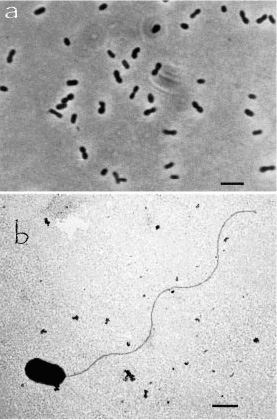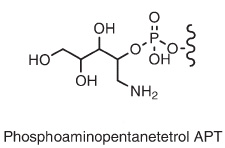Thermodesulfobacterium
A Microbial Biorealm page on the genus Thermodesulfobacterium

Jeanthon et al.
Classification
Higher order taxa:
Bacteria; Thermodesulfobacteria; Thermodesulfobacteria (class); Thermodesulfobacteriales; Thermodesulfobacteriaceae
Species:
Thermodesulfobacterium commune, T. hveragerdense, T. hydrogeniphilum, T. thermophilum
Description and Significance
Thermodesulfobacterium is a Group II sulfate-reducing bacteria because it can can utilize acetate and other fatty acids, oxidizing them completely. It also produces nonisoprenoid branched glycerol diethers (discussed below). Sulfate-reducing bacteria fall into over 20 separate genera and these can be classified by the types of substrates that are utilized. A convenient division is by the ability to utilize acetate as a source of electrons. Other Group II sulfate-reducers include Desulfosarcina and Desulfobacter. For more information on sulfate-reducing bacteria genera, click here
Thermodesulfobacterium commune expresses a unique type of dissimilatory sulfite reductase which is taxonomically distinct from that of related genera or other hyperthermophilic sulfate reducers.
Genome Structure
Thermodesulfobacterium commune Strain DSM 2178. The type strain for this organism is being used for comparative genome analysis, and is not yet finished being sequenced. Click here for more information.
Cell Structure and Metabolism

lipids RCM 2004.pdf Sturt et al
Sulfate reducers have a wide range of cellular morphologies, including rods, vibrios, ovals, spheres and even tear-dropped or onion shaped cells. Some are motile, others are not. Most sulfate-reducing bacteria are mesophilic, but a few thermophiles are known.
T. commune is hyperthermophilic, rod-shaped, anaerobic, has no motility, and no endospores. Interestingly, T. hydrogeniphilum is thermophilic, non-spore-forming, gram-negative, and it cells occur singly or in pairs as small, highly motile rods.
T. commune and T. hveragerdense, two closely related sulfate-reducers, are similar but can be distuingished on the basis of their intact membrane lipids. Both species have the same headgroups but in different proportions. Phosphoethanolamine PE is the major headgroup in both (51% in T. commune and 79% in T. hveragerdense), while Phosphoinositol PI comprises 13% of the IPLs in T. commune and 17% of the Intact Polar Lipids (IPLs) in T. hveragerdense. One major difference is that significant ammounts of DPG bacterial core lipids (left, top) are present in T. commune, while T. hveragerdense contains only traces of it.
The most surprising fact concerning IPLs in these bacteria deals with Non-N-methylated APT (left, bottom), and came from a recent study. The presence of APT had not yet been documented for these two bacteria, and APT was considered extremely rare in the bacterial domain while reasonably common in archaea. It had been reported for the archaeal order Methanomicrobiaceae, which produce the N-methylated APT version; the only bacterial example to date has been a Hydrogenobacter thermophilus strain. However, the study found Non-N-methylated APT present in both species, and in T. commune APT constitutes one of the major groups of IPLs with a relative abundance of 22%. For more information on the interesting ramifications of this discovery click here and look at p.7.
Ecology
Overall, Thermodesulfobacterium's habitat is generally observed to be aquatic. Isolated from volcanic hot springs, deep-sea hydrothermal sulfides, and other marine environments. This is thought to be because although sulfate reduction is thought to be an anaerobic process, sulfate-reducing bacteria (SRB) are also important in aerobic environments if they can proliferate in anaerobic zones. For example, in marine sediments and in aerobic wastewater treatment systems, sulfate reduction accounts for up to 50% of the mineralization of organic matter. Furthermore, sulfate reduction strongly stimulates microbially enhanced corrosion of metals.
References
Microbiology Textbook. Copyright, Timothy Paustian© 1999-2004.

